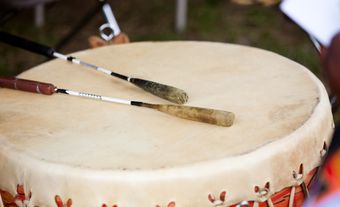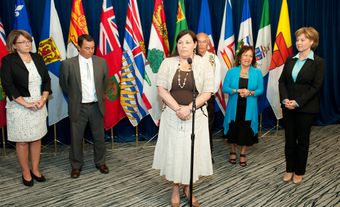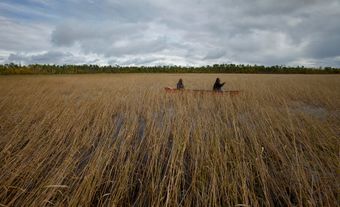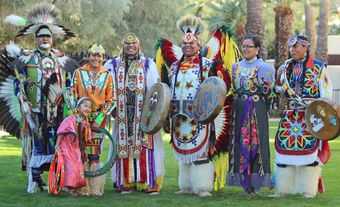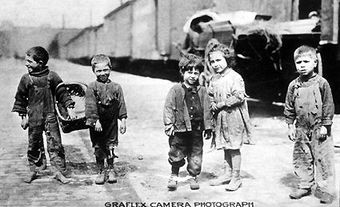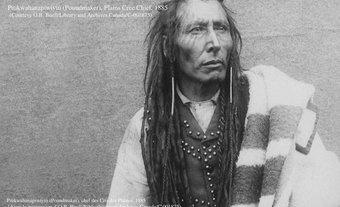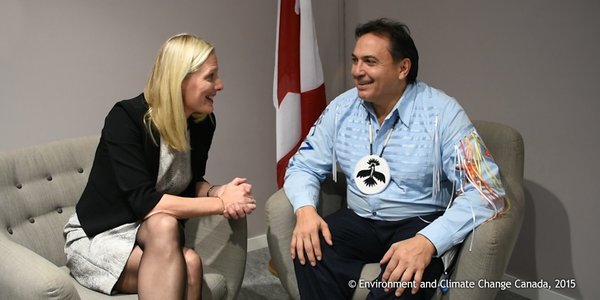
Organization
The Assembly of First Nations (AFN) is led by a national chief, who is elected for a three-year term. The chief is assisted by an executive committee of 10 regionally elected region-chiefs.
The First Nations-in-Assembly meets annually to determine policy and direction, while a Confederacy of Nations — made up of representatives from each region — meets at least twice a year to review assembly resolutions and to address any issues that arise between annual meetings. A Council of Elders develops rules and procedures for the assembly.
The Secretariat (also known as the National Indian Brotherhood) is comprised of the Executive and all administrative, technical and support staff. The AFN also includes a Council of Women and a National Youth Council.
AFN officials lobby MPs, Cabinet ministers and senior government officials to make sure its positions are considered in the formulation of government policy. Secretariats in such areas as education, health, information services, social services and economic development carry on consultations, develop policy and assist individual First Nations. The AFN receives government funding for the work of these secretariats in the form of contribution agreements for specific tasks. Stable funding has been as great a challenge for the AFN as constitutional recognition of First Nations self-government.
History
In 1982, the Assembly of First Nations (AFN) was created as a result of movements to restore chiefs as the voice of First Nations in a Canada-wide deliberative assembly. Prior to that time, the Canada-wide representation of Indigenous peoples in Canada occurred through the National Indian Brotherhood (NIB), which centred on representation through provincial organizations (several of these organizations began as early as the 1920s, and many were based on political traditions dating from before European contact). The NIB had succeeded the National Indian Council (founded 1961, see: Congress of Aboriginal Peoples) and represented Aboriginal interests throughout the 1960s and 1970s under leaders Walter Dieter, George Manuel and Noel Starblanket.
In the late 1970s, First Nations increasingly pushed for the rights of self-government (see Aboriginal Self-Government). Moreover, by the late 1970s, First Nations communities needed direct representation in order to respond to the federal government's constitutional proposals, including the proposed patriation of the Canadian Constitution. In 1979, hundreds of First Nations met in London, England, and determined to establish a new organization, and to stop patriation. Hundreds of chiefs met in Ottawa the following year, outlining their relationships with Canada and with one another in a manifesto entitled the Declaration of First Nations (signed in December, 1980). At the National Indian Brotherhood general assembly in 1982, the Assembly of First Nations was officially founded.
The chiefs declared the Assembly the one and only voice of the First Nations in Canada, and elected David Ahenakew, former president of the Federation of Saskatchewan Indians, as the AFN's first national chief. The AFN maintained the National Indian Brotherhood as its administrative secretariat. The NIB remains the corporate body which enters into legal agreements ranging from funding arrangements with the federal government to leases. This has allowed the AFN to remain a deliberative assembly not subject to the regulations it might face as a corporation operating under a government-granted charter.
First Ministers Conferences, 1983–87
The main thrust of the Assembly of First Nations (AFN) has been to press for the entrenchment of the right of First Nations self-government in the Canadian Constitution, and to gain increased governmental and popular acceptance of the existing constitutional recognition of Aboriginal and treaty rights. When a parliamentary task force on First Nations Self-Government was created in 1982 — the Special Committee of the House of Commons on Indian Self-Government — the AFN was invited to have a non-voting ex-officio member work with the MPs on the committee. The AFN was also involved in the constitutional discussions of the 1980s.
As a result of the Constitution Act of 1982, provision was made for a series of First Ministers Conferences (FMC) "to identify and define" Aboriginal and treaty rights. The AFN represented the First Nations communities at the FMCs of 1983, 1984, 1985 and 1987. However, the positions assumed by the federal and provincial governments made it difficult for the AFN to maintain a unified position. Opinions particularly differed between those First Nations who had participated in the Numbered Treaties and those whose rights depend upon Aboriginal title. In the 11 Numbered Treaties (signed between 1871 and 1921) First Nations ceded large tracts of land in northern Ontario, the Prairies, and parts of British Columbia and the territories in exchange not only for cash settlements, but also for a complex set of obligations from the federal government, including the establishment of reserves, annuities, and hunting and fishing rights. Therefore, the Numbered Treaty nations have an explicit treaty relationship with the federal government, unlike many other First Nations, whose claims are based on the more general concept of inherent Aboriginal Rights to a land or territory (also known as Aboriginal title, see Aboriginal Treaties).
In 1985, chiefs from the Numbered Treaty nations formed the Prairie Treaty Nations Alliance in order to assert their treaty position and ensure the federal government upheld the specific rights guaranteed in the Numbered Treaties. There were further differences of opinion within the AFN because, at the same time as the First Ministers Conferences, the federal government introduced amendments to the Indian Act in 1985 to reinstate some, but not all, former band members who had been struck from band membership. A major concern was that there were no corresponding increases either in land base or in funding for community services.
In 1987, the fourth and final conference in the series of First Ministers constitutional conferences on Aboriginal rights ended without agreement on First Nations self-government. At the final meeting, the AFN issued a Joint Proposal for Aboriginal Self-Government together with the Native Council of Canada, the Métis National Council and the Inuit Committee on National Issues. Within a month of the breakdown of negotiations on Aboriginal rights, the First Ministers met privately at Meech Lake, where they agreed to describe Québec as "a distinct society" in the Canadian Constitution. Georges Erasmus, national chief of the AFN, was among many Aboriginal speakers to express frustration at the discrepancy between the First Ministers' successful accommodation of Québec and the breakdown of negotiations on Indigenous self-government.
Charlottetown Accord
During the constitutional negotiations that led to the Charlottetown Accord in 1992, the Assembly of First Nations (AFN), under Ovide Mercredi, held to the principle that the Aboriginal right to self-government is "inherent" and has not been extinguished by Canadian law (see Charlottetown Accord: Document). This principle was entrenched in the Accord, with some notable restrictions. The Accord was defeated in a public referendum in October 1992. The failure of the Accord has led the AFN to pursue other avenues toward First Nations self-government (see: Land Claims; Aboriginal People, Political Organization and Activism).
Royal Commission on Aboriginal Peoples
After the constitutional talks ended, governments expressed increasing unwillingness to discuss self-government. Consequently, many First Nations turned to local priorities and the role of the national organization appeared to decline. As well, a number of grassroots situations, such as the events at Oka in the summer of 1990 and Ipperwash in 1995, strained the relationship between First Nations and the local, provincial and federal authorities. The 1990 events at Oka and elsewhere across the country resulted in the establishment of the Royal Commission on Aboriginal Peoples (RCAP), of which former National Chief Georges Erasmus was named co-chair. In 1996, the Erasmus-Dussault Commission published a five-volume report with over 400 recommendations for a renewed relationship between Canada and First Nations. Although its critics have often represented the RCAP report as having been “stillborn,” the very presence of the report has tended to define political agendas in this field both for Indigenous leaders and for ministers with responsibility for Indigenous affairs, whether federal or provincial.
Debate within the AFN
In 1997, Phil Fontaine of Manitoba took office as national chief, basing his public agenda on a renewed relationship between First Nations and Canada. He placed particular emphasis on the economic development of First Nations communities, revision of the Indian Act, and a harmonious relationship with the government. This relationship prompted criticism from some First Nations, and contributed to his defeat in the Assembly of First Nations (AFN) elections of 2000 by Matthew Coon Come, who adopted a more confrontational approach. Fontaine was re-elected as national chief in 2003 and 2006, and under his leadership the AFN negotiated both the Kelowna Accord and the Indian Residential Schools Settlement Agreement.
Kelowna Accord
The Assembly of First Nations (AFN) under Fontaine played an important role in the development of what would become known as the Kelowna Accord. In the 18 months leading up to the First Ministers Meeting on 24–25 November 2005 in Kelowna, BC, the Assembly of First Nations and four other Aboriginal organizations met with the federal, provincial and territorial governments to develop a common strategy aimed at improving the quality of life of Aboriginal peoples in Canada.
A paper released at the end of the meeting — “First Ministers and National Aboriginal Leaders: Strengthening Relationships and Closing the Gap” — announced a 10-year plan, including a $5.1 billion commitment over five years. Around $1.8 billion was allocated for education under the plan, with the goal of raising the high school graduation rate to the same level as the rest of Canada. Over $1.3 billion was earmarked for health services; the Accord aimed to reduce infant mortality, youth suicide and childhood diabetes by 20 per cent in five years (and by 50 per cent in 10 years). Another $1.6 billion would be spent on improvements to housing and infrastructure, and $1.7 million on “relationships and accountability” (supporting Aboriginal organizations in developing accountability practices, working with governments, and “engaging on land claim and self-government policies”). Additional funds would go to economic development.
While Paul Martin’s government endorsed the Kelowna Accord, the Liberals lost power shortly after in the general election. The new Conservative government under Stephen Harper agreed with the overall goals of the Accord, but not necessarily with the approach to funding. The Conservative budget of 2006 allocated considerably less funding to these issues than outlined by the Kelowna Accord. In June 2006 Paul Martin introduced Bill C-292 (An Act to Implement the Kelowna Accord), a private member’s bill that was supported by the opposition parties. The Kelowna Accord Implementation Act became law in 2008. In early 2013, during the Idle No More protests, the Accord was held up as a model of Indigenous-Canadian relations by several commentators.
Indian Residential Schools Settlement Agreement
The Assembly of First Nations (AFN) also played a key role in negotiating the Indian Residential Schools Settlement Agreement (IRSSA), which was approved by all parties in May 2006 and came into effect in September 2007. Under the IRSSA, around $1.9 billion was set aside for the direct benefit of former students, while additional funds would compensate those students who were victims of sexual abuse, serious physical abuse and “certain other wrongful acts which caused serious psychological consequences.” The agreement also included $60 million for a Truth and Reconciliation Commission, which would provide opportunities for former students, families and communities to share experiences, as well as promote public awareness and education, and establish a research centre. Funds were also set aside for the Aboriginal Healing Foundation and to commemorate the legacy of the residential schools (see Meech Lake Accord; Meech Lake Accord, Document).
Ongoing Advocacy and Challenges
The Assembly of First Nations (AFN) still faces challenges from some within the First Nations community. An ongoing problem is the perceived nature of the relationship between the AFN and the Canadian government, which some critics allege is too “cosy.” The disunity among First Nations was manifested in the response of Aboriginal individuals and organizations to the government’s Bill C-45 (the “budget omnibus bill”) introduced in October 2012. At over 400 pages of text, the Bill made significant changes to many acts, including the Indian Act, the Navigable Waters Protection Act (changed to the Navigation Protection Act) and the Environmental Assessment Act.
The changes concerned many Canadians and First Nations, and resulted in the formation of the Idle No More movement, which was started by four women from Saskatchewan but quickly grew to include thousands of supporters from Indigenous peoples, Canada and abroad. While the AFN had no official connection to the Idle No More movement, National Chief Shawn Atleo publicly expressed support for the protestors. However, Atleo and the AFN were criticized for not pushing the government hard enough. As Idle No More protesters called for action, Chief Theresa Spence of Attawapiskat went on a liquid fast, calling for a meeting with the prime minister and governor general. Spence’s fast and the Idle No More protest have been credited with adding pressure to the demands by Chief Atleo and the AFN for a high-level meeting with the Prime Minister.
On 11 January 2013, Prime Minister Harper met with Atleo and other members of the AFN. He agreed to “high-level dialogue” on treaty relationships and land claims, greater oversight from the Prime Minister’s Office and the Privy Council, and future meetings with the national chief. Despite this, there was division within the AFN, with some chiefs (such as Grand Chief Derek Nepinak of Manitoba) boycotting the talk. Although she originally decided against attending the meeting, Chief Spence attended the meeting after all. Some chiefs from Ontario and Manitoba even called for a vote of non-confidence in Atleo. Despite such criticism, the AFN was instrumental in persuading both the Liberal and NDP caucuses to endorse a declaration of 13 commitments requested by Chief Spence, which ended her fast in late January 2013.
Criticism of the AFN continued in February 2013, when it was revealed that the organization had worked closely with the RCMP leading up to the 2007 National Aboriginal Day of Action, which included protest rallies and blockades of major transportation routes. Documents revealed that AFN National Chief Phil Fontaine met with the heads of the RCMP and the Ontario and Québec police in the summer of 2007 to coordinate a consistent approach to the protest. Critics alleged that the AFN was working against its own people, and that its dependence on federal funding affected its ability to advocate effectively for First Nations. Like the Idle No More protests, the controversy over AFN cooperation with Canadian law-enforcement organizations illustrates the challenges of the AFN as a national organization representing hundreds of diverse First Nations and communities.
First Nations and Poverty
In July 2019, a report co-authored by the Assembly of First Nations and the Canadian Centre for Policy Alternatives (CCPA) revealed that 47 per cent of the 254,100 status First Nations children in Canada live in poverty. Nationally, status First Nations children are nearly four times more likely to live in poverty than non-Indigenous, non-racialized children. The study, titled Towards Justice: Tackling Indigenous Child Poverty in Canada, was published by Upstream Institute, a national communication think tank. The authors of the report, Natasha Beedie, David Macdonald and Daniel Wilson tracked child poverty using Statistics Canada’s 2006 Census, 2011 National Household Survey and 2016 Census.
In addition to showing that nearly half of all status First Nations children live in poverty, the study revealed differences in the poverty rate for status First Nations children living on-reserve (53 per cent) and those living off-reserve (41 per cent) (see Reserves). Poverty rates were highest on the Prairies, with status First Nations children in Manitoba and Saskatchewan living on reserves facing extreme poverty rates of 65 per cent. In comparison, recent studies reveal that non-Indigenous children in Manitoba and Saskatchewan have poverty rates of 15 per cent and 16 per cent, respectively. In Quebec, the poverty rate for First Nations children living on reserves has fallen to 29 per cent, most likely due to the results of agreements between First Nations and the province to share natural resource revenues (such as Hydro-Québec revenues). The national poverty rate for the 4.5 million non-Indigenous children (not including racialized and recent immigrant children), the biggest group in the country, is 12 per cent.
AFN National Chief Perry Bellegarde declared that “The findings of this report are shameful and underscore the urgent need to invest in First Nations children, families and communities. Our children face the worst social and economic conditions in the country.… It’s beneficial to all Canadians to close the gap in quality of life between First Nations and Canada.” The AFN and authors of Towards Justice believe that a “national poverty strategy,” with self-determination for Indigenous peoples, increased government funding and resource revenue sharing arrangements between Indigenous peoples and government, should be implemented immediately to tackle and reduce child poverty among Indigenous children.

 Share on Facebook
Share on Facebook Share on X
Share on X Share by Email
Share by Email Share on Google Classroom
Share on Google Classroom

